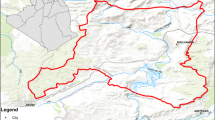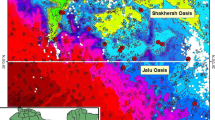Abstract
The city of Caldas Novas, State of Goiás, Brazil, holds the largest thermal water complex in the planet not associated to with volcanism or other kinds of magmatism. Its structural control allows the fractures to be wide and deep enough so the waters can reach 1000 m depth. These waters are extracted mainly by deep wells, from the exploitation of the Paranoá and Araxá Aquifer Systems, emerging at temperatures higher than 59 °C. With a growing demand for water resources, groundwater exploration became an attractive alternative for public supply, due to its abundance, quality and low abstraction cost. In Caldas Novas, due to the population growth over the last decades and the increasing number of tourists, a disordered groundwater consumption drawdown the water levels. In order to survive, these reservoirs depend on rainwater infiltration rates to replenish the thermal springs; however, the lack of environmental management and the high risk of contamination, due to the unconsolidated materials thinness, may threaten the thermal aquifer. This study was based on the hydrochemical characterization of Caldas Novas Thermal Complex waters, including radioactive parameters, whose descriptions in the literature are still scarce. Besides, concerning the prospective increase on touristic activities, physicochemical water analyses are periodically required, being this paper a contribution for such purpose.


Reproduce with permission from Almeida (2011)

Reproduce with permission from Campos et al. (2009)

Reproduce with permission from Campos and Almeida (2012)


Reproduce with permission from Almeida (2011)

Reproduce with permission from (Andrade and Almeida 2012)

Reproduce with permission from Ferreira (2003)




Similar content being viewed by others
References
Almeida L (2011) Study of the applicability of artificial recharge techniques in groundwaters for sustainability of thermal waters in Caldas Novas region (GO). PhD Thesis, University of Brasilia, Brasilia
Andrade AM, Almeida L (2012) Behavior of potentiometric levels of Caldas Novas thermal aquifer (GO) and restriction and control measures applied by the national department of mineral production (DNPM). Águas Subterrâneas 26(1):99–112
APHA (American Public Health Association) (2005) Standard Methods, 21st edn., Method 4500-CO2 C. ASTM D 513-82, Total and Dissolved Carbon Dioxide in Water, Test Method E. APHA, Washington
Artur AC, Bonotto DM, Amaral PGQ, do Galembeck TMB (2013) Methodology for quantifying the inhalation of radon gas in ornamental rocks. Geociências 32(1):166–180
Barbosa EQ (2013) Radon as a soil contamination indicator for hydrocarbons. Monograph, UNESP, Rio Claro
Bonotto DM (2004) Radioactivity in waters: from England to Guarani. Ed. UNESP, São Paulo
Bonotto DM (2006) Hydro(radio)chemical relationships in the giant Guarani aquifer, Brazil. J Hydrol 323:353–386
Bonotto DM (2012) A comparative study of aquifer systems occurring at the Paraná sedimentary basin, Brazil: major hydrochemical trends. Environ Earth Sci 67:2285–2300
Bonotto DM (2014) 222Rn, 220Rn and other dissolved gases in mineral waters of southeast Brazil. J Environ Radioact 132:21–30
Bowen R (1986) Groundwater, 2nd edn. New York, Elsevier
Brasil (2011) Ministry of Health. Ordinance No. 2914, 12/12/11. Disposes about procedures for control and monitoring of water quality for human consumption and its potability standards. Ministry of Health, Brasilia, pp 39–46
Brasil (1945) Mineral Waters Code - Decree Law No. 7841, de 08/08/45. DNPM - National Department of Mineral Production, Rio de Janeiro
Brasil (2005) Ordinance MS No. 518, 03/25/04. Ministry of Health, Brasilia
Campos JEG, Almeida L (2012) Thermal balance applied to artificial recharge of aquifers in Caldas Novas region, Goiás State. Braz J Geo 42:196–207
Campos EC, Costa JFG, Marques JMM (1980) Hydrogeological study project in Caldas Novas region, Goiás. In: ABAS (Brazilian Association of Groundwaters) (ed) Proceedings from I Brazilian Congresso f Groundwaters. ABAS, Recife, pp 401–414
Campos JEG, Tröger U, Haesbaert FF (2009) Hot springs of Caldas Novas, Goiás: a notable occurrence of thermal waters with no association to magmatism. In: Winge M, Schobbenhaus C, Berbert-Born M, Queiroz ET, Campos DA, Souza CRG, Fernandes ACS (eds) Geological and paleontological sites in Brazil, vol 2. CPRM (Mineral Resources Research Company), Rio de Janeiro, pp 177–190
CETESB (Environmental Company of São Paulo State) (1978) Technical Norm L5.127. Sulfide determination in water: methylene blue method. CETESB,São Paulo, 10p
CETESB (Environmental Company of São Paulo State) (2014) Appendix D—Environmental and sanitation meaning of quality variables. CETESB, São Paulo
CETESB (Environmental Company of São Paulo State) (2016) Groundwaters. CETESB, São Paulo
Costa RA, Nishiyama L, Silva GA (2013) Zoning of areas susceptibles to underground water contamination in Caldas Novas, State of Goias, Brazil. Braz Geogr J Geosci Humanit Res Medium 4(1):213–232
Ferreira LET (2003) Evaluation of geothermal resources in Goiás State. ON (National Observatory), Rio de Janeiro, 160p
Haesbaert FF, Costa JFG (2000) Geology and hydrology of Caldas Novas region: adaptation to the decree 312 of the DNPM. Caldas Novas, 123p
Jardim WF (2014) Measurement and interpretation of redox potential (Eh) values in environmental matrices. J Quím Nova 37(7):1233–1235
Lazzerini FT, Bonotto DM (2014) Silicon in groundwaters of Brazil. Ciência e Natura 36(2):159–168
Mason B (1966) Principles of Geochemistry, 3rd edn. Wiley, New York
Peixoto Filho S (2000) Management contribution to the Caldas Novas/Rio Quente Thermal Aquifer. MS Dissertation, Pernambuco Federal University, Recife, 183 pp
Silva LJHDER, Vasconcelos MAR, Silva DVG (2008) Timing and role of the Maranhão River Thrust in the evolution of the neoproterozoic Brasília Belt and Tocantins Province, central Brazil. Gondwana Res 13:352–374
Teixeira Neto A, Costa JEAM, Moura JU, Almeida OFR, Bucci RLF, Casseti V (1986) Caldas Novas Thermal Complex, v. 7. Goiás Federal University, Goiânia
Tonetto EM, Bonotto DM (1999) Implementação de metodologia para a análise química de águas e sua aplicação na caracterização das águas subterrâneas de Águas da Prata (SP). Geociências 18(2):303–325
Zobell CE (1946) Studies on redox potential of marine sediments. AAPG Bull 30:477–509
Acknowledgements
CAPES (Coordination for the Development of Higher Education Personnel) in Brazil is greatly thanked for the scholarship to ML.
Author information
Authors and Affiliations
Corresponding author
Rights and permissions
About this article
Cite this article
Lunardi, M., Bonotto, D.M. Hydrochemical study of the Caldas Novas Thermal Complex (GO), Brazil. Environ Earth Sci 77, 71 (2018). https://doi.org/10.1007/s12665-018-7240-x
Received:
Accepted:
Published:
DOI: https://doi.org/10.1007/s12665-018-7240-x




